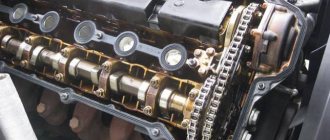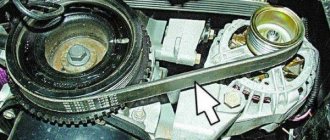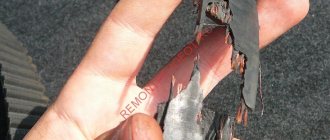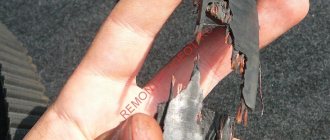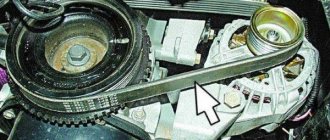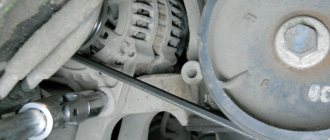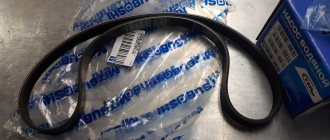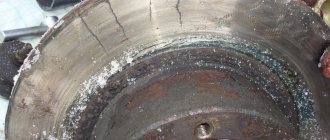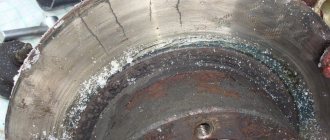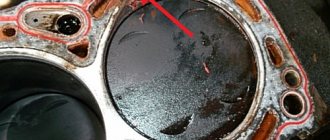How to determine that a car's timing belt has jumped
Like any other car component or part, the timing belt performs certain functions.
It is entrusted with a significant option, and due to the convincingness of its functioning, the operational duration and security of the automotive power plant as a whole is determined. Jumping or slipping of the timing belt is a fairly common phenomenon familiar to many motorists. The belt slips one tooth or several. We are talking about the teeth of the crankshaft or camshaft flywheel. It is clear that such a situation can lead to serious problems.
The timing belt jumped onto a tooth of a VAZ car: signs, symptoms and repair methods
Like any other car component or part, the timing belt performs certain functions. It is entrusted with a significant option, and due to the convincingness of its functioning, the operational duration and security of the automotive power plant as a whole is determined.
Can the timing belt jump?
Author's note: Jumping or slipping of the timing belt is a fairly common phenomenon familiar to many motorists. The belt slips one tooth or several. We are talking about the teeth of the crankshaft or camshaft flywheel. It is clear that such a situation can lead to serious problems.
The main reasons why the timing belt jumps
This is how a timing belt works
The timing belt is an important element of the car, so it needs to be serviced promptly. The reasons that lead to its jump are the following:
- Contact of oil or cooling liquid on the belt surface
- Improper use
- Late replacement
- External damage
- Incorrectly placed labels
- Difficult operating conditions
- Low quality spare parts
Of course, these are not all cases due to which the timing belt breaks or jumps. But this can be understood by the following signs.
Signs and Symptoms of a Timing Belt Jumping
In internal combustion engines that use a timing belt in the timing drive, there is always the danger of it jumping over one or more teeth.
If the timing belt has jumped, the signs of this, depending on the design of the engine, may be the following:
- Unstable engine operation
- The engine stalls
- Power Loss
- Poor startup or inability to start at all
- Engine wedge
Author's Notes: As a rule, if the timing belt jumps within two teeth, the engine will continue to run, but with visible interruptions. When the belt jumps more than two teeth, the consequences can be very different.
Using front-wheel drive vases as an example, the following happens:
- 1.1 and 1.3 liter engines there will be a meeting of valves with pistons with all the ensuing consequences;
- 1.5 and 1.6 liter engines the valves remain intact, but the engine begins to behave inappropriately.
- on some models of modern engines, the valves remain intact, but the rocker breaks, which makes subsequent repairs cheaper.
A similar malfunction, such as a timing belt that has jumped, is usually caused by either an oil leak that has reached the belt teeth, an antifreeze leak, a faulty tension roller, or extreme belt wear.
What to do if your timing belt has jumped one or more teeth
As a rule, a timing belt jump does not immediately lead to extreme problems, but the engine begins to function intermittently or does not start. The explanation is simple: the gas protection phases are incorrect, the general cycle of fuel supply and cylinder cleaning is disrupted.
Timing belt assembly with rollers
The reason for timing belt jumping is often due to the fact that a little oil or coolant drips onto the rubber material of the timing element. The pump is leaking, the cuff of any shaft is malfunctioning - in a word, anything related to oil or liquids can lead to this. Therefore, if you find a malfunction, you must do the following:
When inspecting the engine, oil leaks will be visible on the timing belt cover, so when opening the hood to check the oil level, you should always pay attention to the cleanliness of this cover. If the belt cover has no visible traces of oil, and the engine operation has changed dramatically, you need to remove the cover and check the alignment of the marks and the tension of the timing belt. When traces of oil are found, it is necessary to remove the cover and carefully inspect the belt and find the location of the oil leak. This could be crankshaft or camshaft seals, a leaking pump, or, for example, a leaking oil pressure sensor on VAZ 2108-09 engines and their families
The sensor is located just above the belt cover (top left) and when it is squeezed out, the oil flows just under the belt cover. In such a situation, it is necessary to replace the failed parts and if the timing belt is in oil, then replace the belt as well. After removing the timing belt, it is necessary to clean all parts from traces of oil. When replacing a belt, try to set the marks as accurately as possible, since a belt that is “knocked down” by one tooth will certainly affect the operation of the engine and its starting. This especially applies to diesel engines, which are the most demanding in terms of matching valve timing. If the design does not provide an automatic roller tensioner, then it is necessary to check the belt tension.
Signs and symptoms
There are six main signs that the timing belt has jumped.
- The car engine is unstable.
- The engine constantly stalls.
- Noticeable loss of engine power and thrust.
- The engine starts with problems or does not start at all.
- The power plant is stuck.
- The sound of the engine becomes louder - a metallic knock appears.
Most often, it happens that the product jumps one tooth, and because of this, the engine continues to operate, but increases fuel consumption, and there are also interruptions in operation and starting.
If you suspect that several teeth have jumped, you should not restart the engine. In the worst case, this can cause the valves to bend.
Signs of a jump
You should be able to distinguish the following signs, which, as a rule, indicate an obvious leap.
- If the car engine is unstable.
- The power unit often stalls.
- The engine loses power and pulls poorly.
- Problems with starting, almost one hundred percent.
- Power plant jamming.
The most popular scenario for a jump is this: the power plant continues to function, but interruptions are noticeable. This may indicate that the belt has not jumped completely, but by more than two teeth.
Consequences
The consequences of the timing belt jumping several teeth can be different - from replacing the timing belt itself to repairing the car’s gas distribution mechanism.
The amount of damage depends on whether the engine has recesses for valves in the pistons or not.
A jump can occur while the valves are being lowered to inject fuel or release gases. The pistons are still moving and can hit the valves hard. This will lead to bending of the latter. This situation is similar to a broken timing belt. You can read more about which engines this happens on in this article.
To avoid this situation, it is recommended to do a timely inspection and, if necessary, change the consumable.
Consequences of malfunctions
Problems in the timing chain drive lead to the following problems:
- A stretched and weakened chain jumps several teeth. As a rule, this happens when the engine starts.
- A chain operating with increased free play often breaks the guide and even “gnaws” a groove in the cylinder head made of aluminum alloy.
- In some brands of cars where a single-row chain is used in power units, it may break.
Note. Chain drives of the timing unit can be single- or double-row. The former are not as reliable and durable as the latter, and often break down after a run of 50-80 thousand km. Double-row drives break extremely rarely, even when the owner of the car does not pay due attention to it.
Double-row chains also break, but very rarely
The consequences of these problems may be as follows:
- The most harmless option is a shift in valve timing due to the chain jumping 1-2 teeth. The engine does not start well and vibrates strongly during operation, and there is a clear loss of power while driving. When you press the accelerator pedal sharply, shots are heard in the intake manifold or exhaust pipe.
- When there is a 3 tooth offset, the engine will no longer start. Another thing is that in practice such situations are rare; a too loose chain skips much more. The result is a piston hitting a valve that opened at the wrong time.
- Due to severe wear or breakage of the damper, the chain drive is weakened even more, causing the consequences described above.
- The damage caused by a broken single-row chain depends on the type of engine and the moment when it happened. If all the valves were closed, then the pistons, which continued to move, would not reach their plates.
This is what the valves look like after meeting the pistons
In power units with 8 valves, encounters with the piston are quite rare due to the technological clearances provided for by the design (except for individual motors). But a 16V engine valve that is open when the chain breaks or jumps almost always receives a blow from the piston. As a result, its stem bends and the valve remains in the open position. In especially severe cases, the consequences are as follows:
- even the valve seat and guide bushing are damaged;
- a through hole appears in the upper part of the piston;
- A dent appears on the plane of the cylinder head near the combustion chamber, which makes it necessary to replace it entirely.
A chain that has jumped or broken while driving makes itself felt by a sharp loss of power or complete engine failure. If you were able to hear a metallic knock, indicating the meeting of the piston and valve, then you should prepare for serious repairs to the power unit.
And this is a piston pierced by a valve plate
Have the cams turned on the camshaft, or is this a scam for money?
“Is it possible to turn the cams on the camshafts when the timing belt slips in a 1.7 Isuzu diesel engine, 16 valves? The belt slipped when they tried to start the car with a tow. The repairmen said that the impact on the valves caused the cams on the camshaft to rotate. The car was driving at low speed, so was the impact really so strong that the cams turned? It is alarming that the repairmen, by “lucky” chance, had camshafts from the same engine. They offer to supply them instead of mine. Could this be the case, or do they just want to scam me?”
The repair specialists we interviewed for Opel cars, which were equipped with 1.7-liter Isuzu diesel engines, encountered various consequences of the timing belt slipping or breaking in the specified engine.
Even if the car was driving at low speed, it happened that the force of the pistons hitting the valves was enough not only to break the rocker arms, bend the valves, but also to break off their plates, as well as damage the pistons and even break the camshafts, their supports and bed.
The problem is aggravated by the fact that they tried to start the car from a tow. After the belt breaks and the moving piston further collides with the valve that has stopped and therefore does not have time to hide in the seat, the crankshaft, as a rule, also stops and the engine stalls. But when the belt slipped, while the car was being towed with the gear engaged, the crankshaft and camshaft continued to rotate, and the pistons continued to move and hit the valves. There were most likely several impacts until the driver of the towed car pressed the clutch pedal and turned off the gear.
However, the repairmen did not remember a single fact when, as a result of the timing belt slipping or breaking in a 1.7 diesel engine, the cams turned on the camshaft. We do not rule out that similar facts will emerge when discussing the question asked of us on the ABW.BY forum, but for now we have to rely on the experience and practice of our consultants.
This raises the question: did the repairmen to whom he contacted correctly convey to the owner of the car the essence of what had happened, and also did he correctly understand what he heard from them, and then put it in his letter? It happens that, for the sake of clarity, repairmen resort to incorrect terms and comparisons that can be misinterpreted.
Nevertheless, be that as it may, I would like the repairmen to justify their conclusion more strongly than with just a verbal explanation. What prevents them, in the presence of other camshafts from the same engine, from clearly showing the owner how the standard camshafts became different from them after the impact, what exactly was wrong with them as it should be? If the repairmen themselves are somehow convinced of this, then let them now convincingly visually or by measuring the position of the cams prove to the owner the need for replacement. Otherwise, there is grounds for suspicion that people who repair engines, in addition to the desire to do their job, are driven by additional motives and material interests.
Sergey BOYARSKIKH Photos by the author and from open sources are for illustrative purposes ABW.BY
You have questions? We have the answers. Topics that interest you will be expertly commented on by either specialists or our authors - you will see the results on the website abw.by. Leave questions on the forum or use the “Write to the Editor” button
Repair cost
The average price for replacing a belt and roller in car services ranges from one to three thousand rubles. The price range is due to the fact that replacing parts on foreign cars costs approximately 2–3 times more than on domestic cars.
If it turns out that you also need to change the engine water cooling pump and the crankshaft oil seal, then the price will increase by another 1 - 1.5 thousand rubles.
Although there is a huge selection of products on the market at different price levels, you should only choose brands recommended by the manufacturer or their high-quality analogues. Using cheap parts can lead to serious damage and expensive repairs.
For example, if the valves are bent as a result of a belt slipping, then almost the entire cylinder head will have to be replaced. Even if the repair is carried out by yourself, the cost of replacing valves, pump, belt, filling oil and antifreeze, and other parts will be at least 10,000 rubles.
The timing belt on a car engine ensures synchronization of the crankshaft with the timing shaft (camshaft).
On engines with a timing belt, breaking it or slipping even one tooth can lead to serious problems, which in the future may lead to a major overhaul of the engine.
If the timing belt has jumped or broken
The timing belt on a car engine ensures synchronization of the crankshaft with the timing shaft (camshaft). On engines with a timing belt, breaking it or slipping even one tooth can lead to serious problems, which in the future may lead to a major overhaul of the engine.
Signs of a timing belt that has jumped on the pulley
If the timing belt has jumped, the symptoms may be as follows:
- The engine stalled.
- Unstable motor operation
There may be several reasons why the timing belt may jump. Firstly, low tension, and secondly, the presence of oil on the camshaft or crankshaft pulley can cause the belt to slip. Well, and most importantly, a broken timing belt can ultimately lead to damage to the valves of the gas distribution mechanism and internal elements of the internal combustion engine (pistons, connecting rods, etc.)
Broken timing belt while driving
Causes of timing belt breakage
Why does the timing belt break? There may be several reasons for this, and one of the main ones is its wear and tear. Therefore, the manufacturer strongly recommends replacing the timing belt within the vehicle mileage interval specified by the regulations. Next, it is worth noting that the tension roller is damaged or weakened, which can undoubtedly cause the belt to break or slip. The cause of the break may also be a jammed water pump pulley. If the engine has two camshafts, then the failure of one can also be a consequence of a broken timing belt, but in this case the consequences can be completely different, more disappointing.
Consequences of a broken timing belt on a Lada Priora engine
How to avoid timing belt breakage or slippage
First of all, it is necessary to strictly observe the timing belt replacement interval, in most cases this is 60,000 km. vehicle mileage. Next, keep an eye on the oil seals, including the crankshaft; oil drips under the hood are a sign of one of them leaking. Periodically check the tension of the timing belt; if it becomes loose, immediately take measures to tighten it. Always use original spare parts when replacing a belt. This also includes replacing the pump; buy only the one recommended by the manufacturer.
Find out in more detail when it is necessary to change the timing belt on an internal combustion engine
Photo reports on replacing the timing belt
Opel AstraRenault LoganAudi A4Audi 100Chevrolet LacettiChevrolet AveoOn diesel engines VolkswagenToyota Estima Emina 3CRenault 25Mazda Demio
If the timing belt has jumped or broken
bob312 0
Igor from Karelia 35
Fisherman 9
Igor from Karelia 35
bob312 0
Igor from Karelia 35
bob312 0
Igor from Karelia 35
bob312 0
Igor from Karelia 35
bob312 0
bob312 0
Sasha8688 13
bob312 0
Vovan 337
fantjk 46
Symptoms of malfunction
The main signs that the belt or chain has slipped:
- change in throttle response, power, engine torque;
- increase in the toxicity of exhaust gases, their shade;
- problems when starting the engine;
- a “check engine” error message appears on the dashboard;
- the occurrence of extraneous noise of a non-metallic (for belt drive) and mechanical nature (for both chain and belt drives).
If such signs appear, you should stop driving (start the engine), have the engine diagnosed, or contact a mechanic.
This is how a timing belt works
The timing belt is an important element of the car, so it needs to be serviced promptly. The reasons that lead to its jump are the following:
- Contact of oil or cooling liquid on the belt surface
- Improper use
- Late replacement
- External damage
- Incorrectly placed labels
- Difficult operating conditions
- Low quality spare parts
Of course, these are not all cases due to which the timing belt breaks or jumps. But this can be understood by the following signs.
Gentlemen, has anyone had cases where the belt was not on the marks by 1-2-3 teeth? What are the symptoms and how does it manifest itself in operation? Troits, knocks, rings? Otherwise, there are suspicions after the replacement.
on 3S something like that. With just one tooth, the car started with half a kick, but when you pressed the gas pedal there was a ringing sound in your fingers. My father-in-law's Crown 1G refused to start at all)))
When pressing the gas at idle or while driving? I just get a ringing sound when I move and lightly press the gas.
What's stopping you from removing the covers and checking the marks? If everything is fine, then the electrician needs to set the ignition with a strobe light (in this case, a jumper is placed in the diagnostic connector between Te1 and e1)
both in place and on the move
I really appreciate your participation and admit that I did not provide complete information about the car. You see, I have a 7A-LB engine and the ignition on it is not adjustable. In addition, having worked as a diagnostician myself (albeit for Volvos), I would not have asked a respected forum for help if everything was so simple.)
Wow, this is not my case, I only have it while moving and only with a fully warmed up engine.
I'm waiting for more comments)
By the way, the same canoe after replacing the timing belt, according to the marks, everything is correct, I removed the cover twice, but the ignition stops earlier, I feel it, detonation appears too often. When the heat is not scary, but when frosts start, there may be problems with starting. Even if you fill the gasoline with 98, it still makes a jingling sound. And the tooth here and there won’t be anything terrible, just not big problems. On the jig, I specially threw the chain over one tooth when I went long distance, it ran more fun.
It’s very wrong for you to think so about a mistake of one tooth. Yes, it will start without problems even by 2-3 teeth, but it won’t drive normally even with a mistake of one tooth or it will start guzzling fuel like crazy. Zhiguli is not an example, you know why. And what are the problems, check the installation of the timing belt, there are a lot of books there, everything is simply described there, or ask someone who knows.
By the way, as an option, detonation occurs from severe coking of the CPG, then detonation is practically invincible without drastic measures.
How to determine if a chain drive is faulty
Unlike the timing belt drive, which is located outside the engine, the chain with gears is located inside the power unit and is completely hidden from view. On the one hand, this is a plus: the mechanism makes less noise and is generously lubricated with engine oil, which increases its service life. On the other hand, without removing the valve cover it is impossible to visually assess the technical condition of the unit.
The first sign of a chain drive problem is a rumbling sound coming from under the cover when the power unit is operating. The rumble of a weakened chain cannot be confused with anything; it is heard from the side where the gas distribution mechanism is located.
Loosening with a gap of up to 1 cm allows the chain to jump when starting the engine
Having heard such a sound, the car owner should check the condition of the drive so as not to encounter big troubles associated with engine repair. There are 2 ways: immediately go for diagnostics to the nearest car service center, or remove the valve cover yourself and make sure that the section of the chain near the camshaft gear is loose. Worsening tension is caused by the following reasons:
- due to stretching to such a length that the tensioning device is unable to pick up the slack;
- due to a faulty tensioner;
- the damping plate is worn out or torn;
- Due to the high mileage of the car, all the parts of the mechanism have worn out - the chain, gears, tensioner and damper.
More about Nissan: Symbols on the dashboard
If an old-style mechanical tensioning device is installed in the car engine, then when the described symptoms appear, the first action is to tighten the chain with its help. To do this, simply loosen the outer nut holding the plunger spring and manually turn the crankshaft 1-2 turns.
Old VAZ 2101–07 engines have a mechanical tensioner with a nut
Modern automatic hydraulic tensioners are not designed for manual adjustment and must be replaced if they break. You can verify that the element has failed only by removing it or disassembling the entire timing belt assembly. The same applies to the damper - on most cars, its wear can only be assessed when the mechanism is disassembled.
Ignoring the rumbling noise made by the chain will sooner or later lead to motor failure. The severity of the consequences depends only on your luck.
P0340 or the timing belt does not hit 1 tooth - logbook Hyundai Getz 1.6 16V 2004 on DRIVE2
The receipt from the purchase was on fire. The owner threw up his hands, saying he blinked when it caught fire, but the car was running, so there was no need to get into it. I immediately thought it was error 340 - an error in the camshaft sensor circuit. The Internet said that it was the Khan sensor, that oil could get into its contact and that’s all, provided that the car was driving. I accidentally came across on some website about other cars in general that the same error was on, but as it turned out, the timing belt did not hit 1 tooth according to the marks. The car is moving, but the gas timing is already off. In contact with the Goetz group, the guru immediately said that if the timing belt is knocked off by 1 tooth, then the valves will knock. In the group of accent guides (their motor), essentially no one answered anything. And the other day, one comrade in the accent group made a note that error 342 was on, he opened the covers, and there on the camshaft pulley the mark did not match by 1 tooth, he set everything again, the error went out and the car froze. Well, I read a lot of manuals (most smart), bought a 22 head and went to the garage with jitters and trembling in my knees) I’ll say right away that there’s nothing complicated, just very scary.
Broken timing belt: causes and consequences
Purpose of the timing belt
The timing belt is an important element responsible for the synchronous and harmonious operation of the camshaft and crankshaft of an internal combustion engine. The part is responsible for the function of timely opening and closing of valves. A fully functional belt turns the camshaft at a strictly specified pace - exactly two times slower than the crankshaft turns. During the rotation of the camshaft, a fuel-air mixture (FA) is supplied to the engine cylinders, and exhaust gases are discharged through the exhaust system. A broken timing belt disrupts the entire normal operating cycle of the power unit, and can lead to serious consequences.
Belt drive was introduced by manufacturers to produce lighter and cheaper automobile engines. At the same time, the noise of the running motor has been significantly reduced. But ordinary consumers paid for everything. Innovations in terms of installing the timing belt have brought problems with maintenance and replacement. The service life of a belt drive is much shorter, and during its operation one should constantly “monitor” its condition and tension.
The designers implied that the timing belt itself must simultaneously have high strength, which is close to the chain, and be completely elastic and wear-resistant. As a result of design efforts, a three-layer timing belt design appeared.
Timing belt replacement interval
Even if the engine’s performance is satisfactory, do not forget to timely check the condition of the timing belt, because it also has a wear limit. You can find out this value from the car’s technical passport, but you can do it much simpler: it is recommended to change the spare part every 50 thousand kilometers. If you bought a used car and don't know when it was last replaced, visually inspect the belt. The appearance of microcracks on the body is the first sign of concern.
However, do not panic, because microcracks do not mean that the assembly will break at the first load. Inside it has a metal base made of thin rods. This allows you to withstand impressive shock loads and not tear for a long period of time. On some models, automakers install impact-resistant belts with reinforced metal cord. Thus, it is possible to extend the service life by approximately 30%.
Causes of timing belt breakage
There are several reasons why the timing belt breaks, and to determine them you need to have at least a little understanding of the structure of the power unit. Often, drivers encounter this problem after replacing a belt or repairing the gas distribution mechanism, which is associated with replacing valve guides.
Causes of timing belt breakage
The timing belt is one of the main elements of a car that needs to be serviced promptly and efficiently. In this case, the reasons for a broken timing belt may be the following:
Untimely replacement of the unit. As a rule, the manufacturer recommends replacing the product after 60-70 thousand kilometers. But recommendations may differ - each manufacturer can indicate its own time parameters, which are often more or less than the period we mentioned.
Incorrect operation. The belt can break not only due to natural aging, but due to errors in the operation of the entire unit. For example, if the tensioners, rollers or pump jam while driving, the resulting impulse can lead to a rupture of the timing belt. It looks strong and doesn't tear. When the rotation of the crankshaft reaches 5-6 thousand revolutions, any sudden impulse can lead to irreparable consequences. Particular attention should be paid to belt tension. Often the cause of rupture is its constriction. On the other hand, weakening the tension can lead to a problem with similar consequences - the belt jumping off the pulley grooves. There is a high probability of the same situation if there is strong play in one of the pulleys. That is why it is so important to promptly check the timing belt tension and the condition of all system elements.
Oil getting on the surface. When the first traces of oil or coolant appear on the timing belt, the product must be replaced. Otherwise, the entire gas distribution mechanism may not operate efficiently, the belt may slip, jump off the pulley, or even break. Many car enthusiasts make a big mistake - they simply wipe off the existing dirt with a rag and continue to use the car.
As practice shows, once technical liquid gets on the belt texture, it is no longer possible to remove it. Rubber literally absorbs oil and loses its quality. You can only save yourself by replacing it.
Low quality product. When purchasing a timing belt on the market “cheaply,” be prepared for “surprises” during operation. Please note that saving in this matter will inevitably lead to even greater costs in the future. If you are going to buy parts for a car, they must be original. In this case, you will be absolutely sure of their quality and declared service life. Service station technicians are well aware of situations where, because of a few hundred rubles in savings, car owners spent tens of thousands on repairs. This is not surprising, because a low-quality timing belt may not last even 20 thousand kilometers. Believe me, driving and expecting the belt to hold up at any time is not the best pleasure.
External damage. Due to natural wear and tear or poor quality, various defects may appear on the belt, for example, indentations, cracks, peeling of threads at the end of the product, and so on. Such defects cannot and cannot be eliminated. The only solution in this case is to install a new belt. You shouldn’t ignore the problem either, because at maximum load even a small defect will develop very quickly and cause the belt to break. Subsequently, you can blame yourself for a long time for being slow, but you can’t return the past.
Broken timing belt: causes and consequences
Purpose of the timing belt
The timing belt is an important element responsible for the synchronous and harmonious operation of the camshaft and crankshaft of an internal combustion engine. The part is responsible for the function of timely opening and closing of valves. A fully functional belt turns the camshaft at a strictly specified pace - exactly two times slower than the crankshaft turns. During the rotation of the camshaft, a fuel-air mixture (FA) is supplied to the engine cylinders, and exhaust gases are discharged through the exhaust system. A broken timing belt disrupts the entire normal operating cycle of the power unit, and can lead to serious consequences.
Belt drive was introduced by manufacturers to produce lighter and cheaper automobile engines. At the same time, the noise of the running motor has been significantly reduced. But ordinary consumers paid for everything. Innovations in terms of installing the timing belt have brought problems with maintenance and replacement. The service life of a belt drive is much shorter, and during its operation one should constantly “monitor” its condition and tension.
The designers implied that the timing belt itself must simultaneously have high strength, which is close to the chain, and be completely elastic and wear-resistant. As a result of design efforts, a three-layer timing belt design appeared.
Timing belt replacement interval
Even if the engine’s performance is satisfactory, do not forget to timely check the condition of the timing belt, because it also has a wear limit. You can find out this value from the car’s technical passport, but you can do it much simpler: it is recommended to change the spare part every 50 thousand kilometers. If you bought a used car and don't know when it was last replaced, visually inspect the belt. The appearance of microcracks on the body is the first sign of concern.
However, do not panic, because microcracks do not mean that the assembly will break at the first load. Inside it has a metal base made of thin rods. This allows you to withstand impressive shock loads and not tear for a long period of time. On some models, automakers install impact-resistant belts with reinforced metal cord. Thus, it is possible to extend the service life by approximately 30%.
Causes of timing belt breakage
There are several reasons why the timing belt breaks, and to determine them you need to have at least a little understanding of the structure of the power unit. Often, drivers encounter this problem after replacing a belt or repairing the gas distribution mechanism, which is associated with replacing valve guides.
Causes of timing belt breakage
The timing belt is one of the main elements of a car that needs to be serviced promptly and efficiently. In this case, the reasons for a broken timing belt may be the following:
Untimely replacement of the unit. As a rule, the manufacturer recommends replacing the product after 60-70 thousand kilometers. But recommendations may differ - each manufacturer can indicate its own time parameters, which are often more or less than the period we mentioned.
A little theory
Chain drives transmit rotational force from the crankshaft to the camshaft, which is located in the cylinder head of overhead valve engines.
Chains are divided into 2 categories. They can be toothed or roller. Roller mechanisms, unlike gear ones, are not so widespread. Therefore, it is gear systems that are most often found on cars with a timing belt, which include a chain drive.
Gear units are distinguished by their high smoothness, they are quite reliable, and produce an insignificant level of noise during the operation of the internal combustion engine. In terms of their characteristics, the use of toothed chains brings them much closer to belt drives. One can argue endlessly about which one is better.
But we won’t dwell on this today.
The chain is tensioned due to the operation of hydraulic tensioners, for which motor oil is used as a working fluid. The lubricant is supplied through the engine lubrication system.
Depending on the number of camshafts, that is, camshafts, the number of tensioners also differs. On cars there are from 1 to 3 units.
The service life of the chain directly depends on what the element is made of, how high quality it is and the degree of effectiveness of the heat treatment performed. Similar requirements are placed on timing sprockets, since they constantly operate together with the chain.
More about Nissan: NISSAN Almera Classic body geometry control points
Do not forget about the influence on the condition of the unit of the engine lubrication system, the quality of the oil itself and timely replacement of the fluid.
In practice, when the part is made of high-quality materials, and the correct tension was carried out as part of the service, plus lubricant was introduced on time, then replacing the chain may be necessary at the same time as replacing the motor itself.
That is, you understand that a stretched chain cannot function for a long time and effectively. If you want to extend the life of this unit, initially take a high-quality chain, adjust its tension correctly and lubricate the drive generously with high-quality oil.
